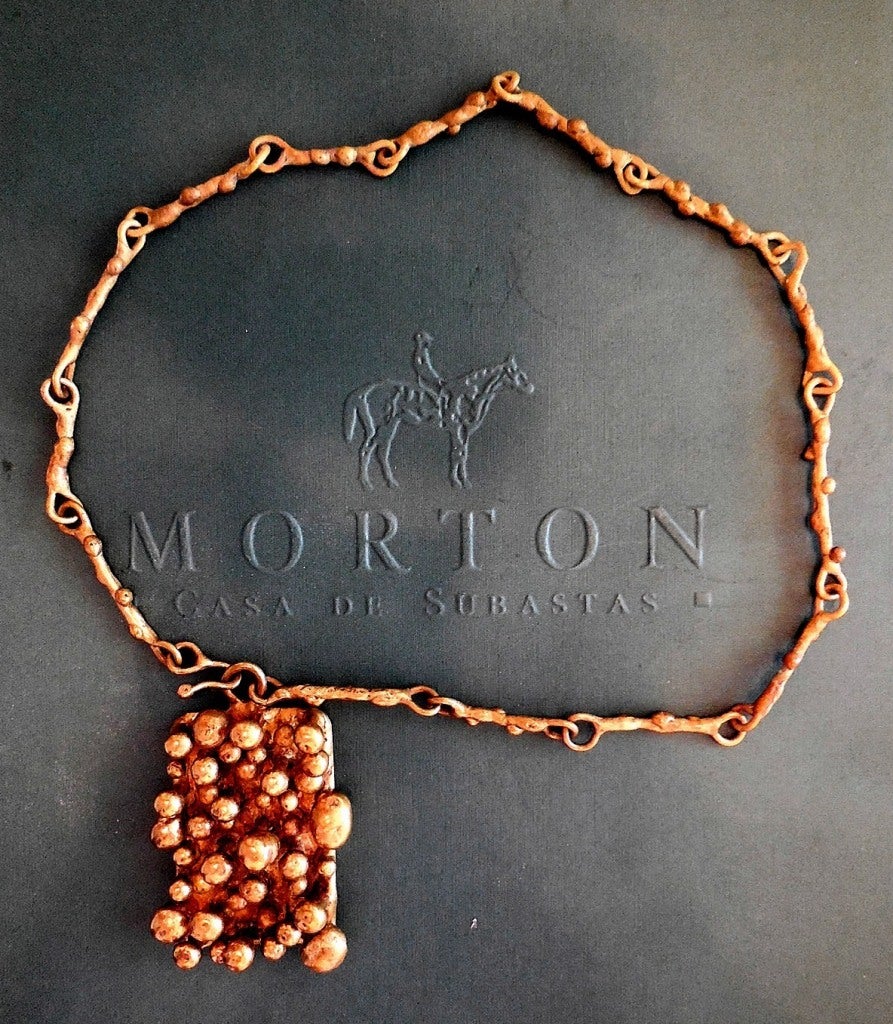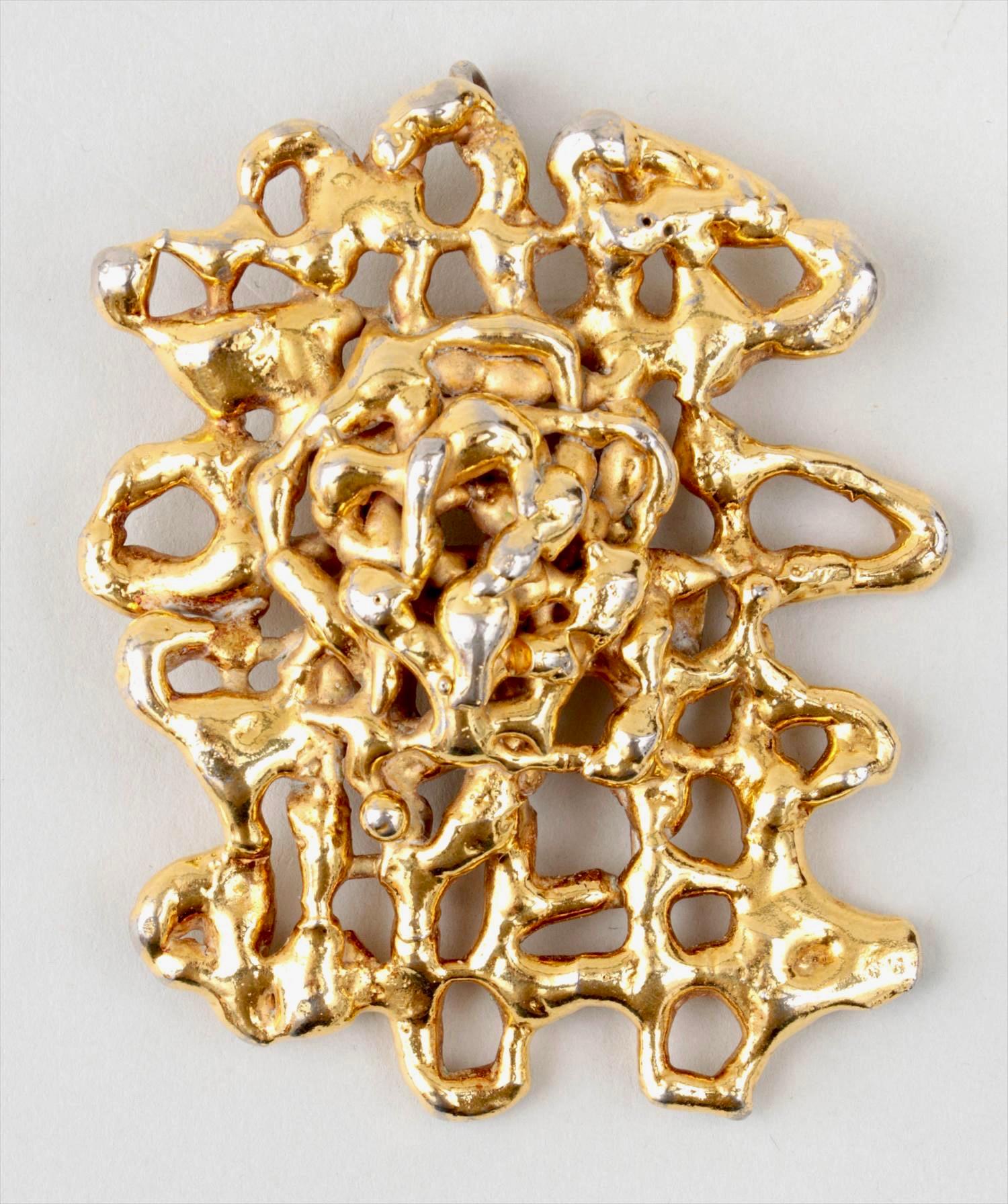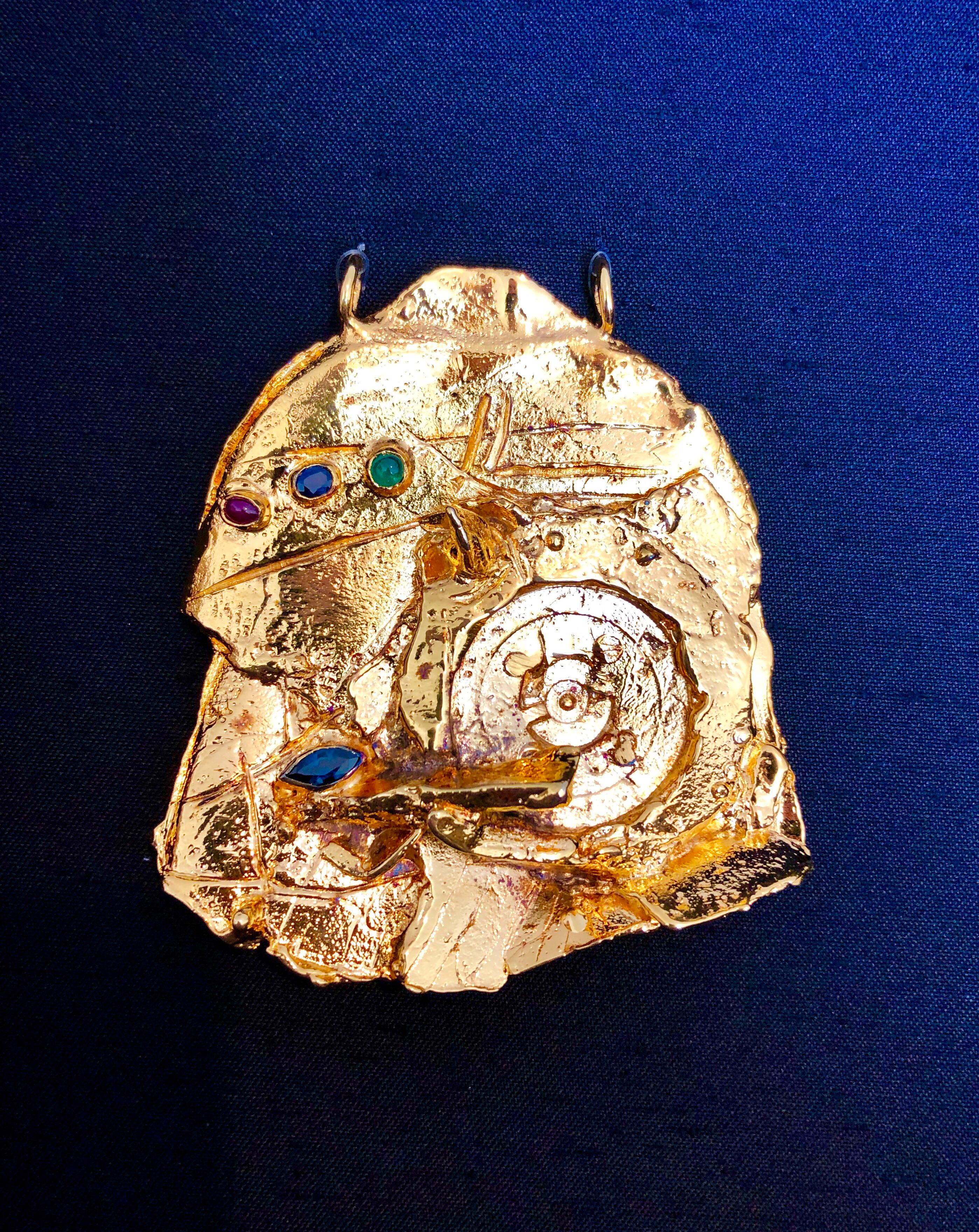Items Similar to Two spiral pins fibula, Hallstatt, 1st Iron Age, Bronze, Sculpture, Antiquities
Want more images or videos?
Request additional images or videos from the seller
1 of 5
UnknownTwo spiral pins fibula, Hallstatt, 1st Iron Age, Bronze, Sculpture, Antiquities9-6 before j.c
9-6 before j.c
About the Item
Two spiral pins fibula, Hallstatt, 1st Iron Age, Bronze, Sculpture, Antiquities
Two spiral pins fibula
9-6 centuries before j.c
Bronze with green and brown patina
Provenance :
Collection of Magister K., Austria
- Creation Year:9-6 before j.c
- Dimensions:Height: 10.12 in (25.7 cm)Width: 10.16 in (25.8 cm)
- Medium:
- Period:
- Condition:
- Gallery Location:Geneva, CH
- Reference Number:1stDibs: LU150228356002
About the Seller
5.0
Recognized Seller
These prestigious sellers are industry leaders and represent the highest echelon for item quality and design.
Established in 2007
1stDibs seller since 2021
11 sales on 1stDibs
Typical response time: 5 hours
- ShippingRetrieving quote...Ships From: Geneva, Switzerland
- Return PolicyA return for this item may be initiated within 7 days of delivery.
More From This SellerView All
- Spiral fibula, Hallstatt, 1st Iron Age, Bronze, Sculpture, Design, AntiquityLocated in Geneva, CHSpiral fibula, Hallstatt, 1st Iron Age, Bronze, Sculpture, Design, Antiquity Spiral fibula 9-6 centuries before J.C Bronze with green and brown patina Provenance : Collection of D...Category
15th Century and Earlier Abstract Sculptures
MaterialsBronze
- Spiral fibula, Hallstatt, 1st Iron Age, Bronze, Sculpture, Antiquities, DesignLocated in Geneva, CHSpiral fibula, Hallstatt, 1st Iron Age, Bronze, Sculpture, Antiquities, Design Spiral Fibula 9e-6e before j.c Bronze with brown and green patina Provenance : Collection of AigenbauerCategory
15th Century and Earlier Abstract Sculptures
MaterialsBronze
- Pomme Bouche, Brooch, Claude Lalanne, French, Design, 1990's, Bronze, JewelsBy Claude LalanneLocated in Geneva, CHPomme Bouche, Brooch, Claude Lalanne, French, Design, 1990's, Bronze, Jewels Brooch Pomme Bouche 1990 Edition Arthus-bertrand, Paris Bronze with a golden...Category
1990s Art Nouveau Abstract Sculptures
MaterialsBronze
- Buste de faune, Picasso, Ceramic, Terracotta, Faune, Mythological, Design, 1950'By Pablo PicassoLocated in Geneva, CHBuste de faune, Picasso, Ceramic, Terracotta, Faune, Mythological, Design Buste de faune Unique piece Partially glazed terracotta 18.5 x 9.3 cm 40 x 32 cm (with frame) Certificate o...Category
Mid-20th Century Post-War Abstract Sculptures
MaterialsTerracotta
- Visage, Pablo Picasso, Face, 1950's, Ceramic, Madoura, Sculpture, EarthenwareBy Pablo PicassoLocated in Geneva, CHVisage, Pablo Picasso, Face, 1950's, Ceramic, Madoura, Sculpture, Earthenware Ed. 500 pcs White earthenware clay, decoration in engobes under glaze Inscribed on the reverse: Edition...Category
1950s Post-War Abstract Sculptures
MaterialsEarthenware, Clay
- Visage dans un carré, Picasso, plate, multiples, edition, 1950's, portrait, faceBy Pablo PicassoLocated in Geneva, CHVisage dans carré Ed. 59/100 pcs 1956 White earthenware clay, engobe decoration under partial brushed glaze, ivory, blue D. 42.2 cm Numbered, incised and stamped on the reverse : 59/...Category
1950s Post-War Abstract Sculptures
MaterialsCeramic, Clay, Earthenware
You May Also Like
- Sculptures 'Wandobjekt' by Carola Eggeling, Bronze and AluminumBy Carola EggelingLocated in Paris, FRSculptures 'Wandobjekt' by Carola Eggeling Abstract sculpture with beautiful curved lines. Set of 3 German aluminum and bronze sculptures Finishes: - Aluminum white lacquered - Al...Category
21st Century and Contemporary Abstract Abstract Sculptures
MaterialsBronze, Steel
- Gold Gilt Bronze Sculpture Pendant Israeli Tumarkin Abstract Modernist JewelryLocated in Surfside, FLMeasures about 4.25 X 2.25 inches. Box frame is 17 X 13 inches. Signed by artist verso. From the literature that I have seen I believe the edition size was limited to 10, I do not kn...Category
1960s Modern Abstract Sculptures
MaterialsGold, Bronze
- Rare Brutalist Mexican Sculpture Pendant Necklace Signed Bronze Pal KepenyesBy Pal KepenyesLocated in Surfside, FLChain measures 19.5 inches in length Pendant measures 2.4 X 1.5 X .5 inches Pal Kepenyes is a sculptor and researcher of Hungarian art, whose artistic production includes sculptures of small and medium format, jewelry and miniature decorative pieces, all made by hand, without any machinery. Wearable art. Sculptural pendant on matching chain cast in polished bronze or brass. Reminiscent of Harry Bertoia. Organic Modernism. Mod, space age, handmade artisan, studio jewelry. Pal Kepenyes, wearable art pioneer. sculptor, goldsmith, jeweler, artist, was born in 1926 in Hungary. His creative talent, specifically in creating sculpted works, was evident early on. He moved to Budapest, where he first studied at the University of Arts and Crafts and later at the Academy of Fine Arts. His professor, Beni Ferenczy was one of Hungary's most influential sculptors. Pal Kepenyes (20/21st century) is active/lives in Hungary, Mexico. Pal Kepenyes is known for sculpture, jewelry making, miniature decorative pieces especially influenced by Mexican folk art and folklore. His work also includes animals, lions, tigers, fish, nude figures and milagros. He began his studies at the School of Decorative Arts in Budapest, and then was a prisoner of war during the Stalinist regime. In 1956, at the end of the Hungarian Revolution, he finally was released and left the country for Paris, where he studied at the School of Fine Arts. In 1956, he also traveled to Mexico, a country to which he has been devoted for the rest of his life because of his attraction pre-hispanic cultures. Along with Pedro Friedeberg, Arnold Coen, Vladimir Cora, Byron Galvez, Mathias Goeritz, Leonardo Nierman, Gabriel Orozco...Category
1960s Modern Abstract Sculptures
MaterialsBronze
- Vintage Abstract Expressionist Ibram Lassaw Modernist Bronze Sculpture PendantBy Ibram LassawLocated in Surfside, FLIBRAM LASSAW (Russian-American, 1913-2003), Sculptural pendant Gold plated bronze Signed verso Measurements: 2-7/8''h, 2-1/4''w. Ibram Lassaw was born in Alexandria, Egypt, of Russian Jewish émigré parents. After briefly living in Marseille, France, Naples, Italy Tunis, Malta, and Constantinople, Turkey his family settled in Brooklyn, New York, in 1921.His family settled in Brooklyn, New York. He became a US citizen in 1928. Ibram Lassaw, one of America's first abstract sculptors, was best known for his open-space welded sculptures of bronze, silver, copper and steel. Drawing from Surrealism, Constructivism, and Cubism, Lassaw pioneered an innovative welding technique that allowed him to create dynamic, intricate, and expressive works in three dimensions. As a result, he was a key force in shaping New York School sculpture.He first studied sculpture in 1926 at the Clay Club and later at the Beaux-Arts Institute of Design in New York. He made abstract paintings and drawings influenced by Kandinsky, Sophie Taeuber Arp, and other artists. He also attended the City College of New York. Lassaw’s encounter with avant-garde art in the International Exhibition of Modern Art (1926), organized by the Société Anonyme at the Brooklyn Museum, made a powerful impression on him. In the early 1930s he explored new materials and notions of open-space sculpture. The ideas of László Moholy-Nagy and Buckminster Fuller were important to him, and he knew the work of Julio González, Pablo Picasso, and the Russian Constructivists. After experimenting with plaster, rubber and wire, Lassaw began working with steel, which became a frequent medium for the artist, along with other metals. His work reflects the influence of Surrealist artists such as Alberto Giacometti and Joan Miro as well as American Modernist Alexander Calder.A pioneer of abstract sculpture in the United States, in 1936 Lassaw was a founding member of the organization American Abstract Artists. Between 1933 and 1942 he worked for various federal arts projects: the Public Works of Art Project, Civil Works Authority, and WPA, the Works Progress Administration Federal Art Project. In 1938 he produced his first welded work. He served with the U.S. Army, where he learned direct welding techniques. During the 1940s he experimented with cage constructions and with acrylic plastics, adding color to his sculptures by applying dye directly to their surfaces. In 1949 Lassaw was a founder of the Club, an informal discussion group of avant-garde artists that had developed from gatherings at his studio, on Eighth Street. During the mid-1930s, Lassaw worked briefly for the Public Works of Art Project cleaning sculptural monuments around New York City. He subsequently joined the WPA as a teacher and sculptor until he was drafted into the army in 1942. Lassaw's contribution to the advancement of sculptural abstraction went beyond mere formal innovation; his promotion of modernist styles during the 1930s did much to insure the growth of abstract art in the United States. He was one of the founding members of the American Abstract Artists group, and served as president of the American Abstract Artists organization from 1946 to 1949. In 1951, Samuel Kootz invited Lassaw to join his gallery in New York. He also had a summer gallery in Provincetown, MA. Lassaw had been summering in Provincetown since 1944, and in 1951 rented an apartment next door to the Kootz Gallery. Among the artists in the Kootz Gallery were Jean Arp, William Baziotes, Georges Braque, Jean Dubuffet, Herbert Ferber, Arshile Gorky, Adolph Gottlieb, David Hare, Hans Hofmann, Fernand Leger, Georges Mathieu, Joan Miró, Robert Motherwell, Pablo Picasso, Pierre Soulages, and Maurice de Vlaminck. Lassaw is a sculptor who was a part of the New York School of Abstract expressionism during the 1940s and 1950s. Jackson Pollock, Lee Krasner, James Brooks, Willem de Kooning, and several other artists like Lassaw spent summers on the Southern Shore of Long Island. Lassaw spent summers on Long Island from 1955 until he moved there permanently in 1963. SELECT EXHIBITIONS 1961 International Exhibition of Modern Jewelry 1890–1961, organized by the Worshipful Company of Goldsmiths in association with the Victoria and Albert Museum, London 1967 Exhibition of Jewelry by Painters and Sculptors, organized for circulation by MoMA 1973 Jewelry...Category
Mid-20th Century Abstract Expressionist Abstract Sculptures
MaterialsGold, Bronze
- Gilt Bronze Sculpture Brooch Wearable Art Israeli Tumarkin Abstract SurrealistLocated in Surfside, FLMeasures about 3.75 X 3.5 inches. Box is 11 X 11 inches. (Piece is in excellent condition. box frame has some minor wear and piece might need to be remounted, it has been removed and the back taken off for the photograph.) Abstract Surrealist gold gilt cast bronze wearable art pendant sculpture (or silver, it is heavy) with precious or semi precious gem stones set into it. This is most probably from the series done with Mayer Swed Jewelers in Tel Aviv. Similar ones with gold gilding and semi precious gemstones from this series have come up at Tiroche auction in Herzliya with estimates from 2500$-3500$ (sold for 3220$ in 2011). This is from the period of the wearable art movement when artists like Alexander Calder, Ibram Lassaw and Clare Falkenstein amongst many others were turning to jewejry as an expressive medium for their art. Yigal Tumarkin (also Igael Tumarkin) (born 1933) is an Israeli painter and sculptor. Biography Peter Martin Gregor Heinrich Hellberg (later Yigal Tumarkin) was born in Dresden, Germany. His father, Martin Hellberg, was a German theater actor and director. His mother, Berta Gurevitch and his stepfather, Herzl Tumarkin, immigrated to Mandate Palestine when he was two. Tumarkin served in the Israeli Navy. After completing his military service, he studied sculpture in Ein Hod, a village of artists near Mount Carmel. Johanaan Peter worked there with Hans Jean Arp and Dada artist Marcel Janco pioneering Modernist studio Jewelry in Israel. Tumarkin did some Jewelry as awards for the state of Israel (along with Yaacov Agam, Jacques Lipchitz, Salvador Dali, Samuel Bak, Dani Karavan and others.) This is not from that edition but much more rare studio produced limited edition sculptural pieces. Among Tumarkin's best known works are the Holocaust memorial in Rabin Square, Tel Aviv and his sculptures commemorating fallen soldiers in the Negev. Tumarkin is also a theoretician and stage designer. In the 1950s, Tumarkin worked in East Berlin, Amsterdam, and Paris. Upon his return to Israel in 1961, he became a driving force behind the break from the charismatic monopoly of lyric abstraction there. Tumarkin created assemblages of found objects, generally with violent Expressionist undertones and decidedly unlyrical color. Hebrew. His determination to "be different" influenced his younger Israeli colleagues. The furor generated around Tumarkin's works, such as the old pair of trousers stuck to one of his pictures, intensified the mystique surrounding him.Tumarkin has worked extensively in the medium of printmaking, producing over three hundred prints. He was encouraged by the print studios founded during those years in the USA, where prominent artists such as Jasper Jones...Category
1960s Surrealist Abstract Sculptures
MaterialsGold, Bronze
- Gold Gilt Bronze Sculpture Brooch Art Israeli Tumarkin Abstract SurrealistLocated in Surfside, FLMeasures about 4 X 3.75 inches. Box frame is 17 X 13 inches. Signed by artist verso. From the literature that I have seen I believe the edition size was limited to 10, I do not know ...Category
1960s Modern Abstract Sculptures
MaterialsGold, Bronze





